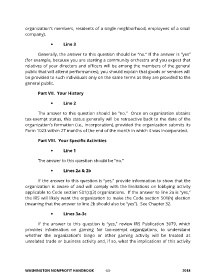Page 94 - Washington Nonprofit Handbook 2018 Edition
P. 94
organization’s members, residents of a single neighborhood, employees of a small
company).
y Line 3
Generally, the answer to this question should be “no.” If the answer is “yes”
(for example, because you are starting a community orchestra and you expect that
relatives of your directors and officers will be among the members of the general
public that will attend performances), you should explain that goods or services will
be provided to such individuals only on the same terms as they are provided to the
general public.
Part VII. Your History
y Line 2
The answer to this question should be “no.” Once an organization obtains
tax-exempt status, this status generally will be retroactive back to the date of the
organization’s formation (i.e., incorporation), provided the organization submits its
Form 1023 within 27 months of the end of the month in which it was incorporated.
Part VIII. Your Specific Activities
y Line 1
The answer to this question should be “no.”
y Lines 2a & 2b
If the answer to this question is “yes,” provide information to show that the
organization is aware of and will comply with the limitations on lobbying activity
applicable to Code section 501(c)(3) organizations. If the answer to line 2a is “yes,”
the IRS will likely want the organization to make the Code section 501(h) election
(meaning that the answer to line 2b should also be “yes”). See Chapter 32.
y Lines 3a-3c
If the answer to this question is “yes,” review IRS Publication 3079, which
provides information on gaming for tax-exempt organizations, to understand
whether the organization’s bingo or other gaming activity will be treated as
unrelated trade or business activity and, if so, what the implications of this activity
WASHINGTON NONPROFIT HANDBOOK -83- 2018

